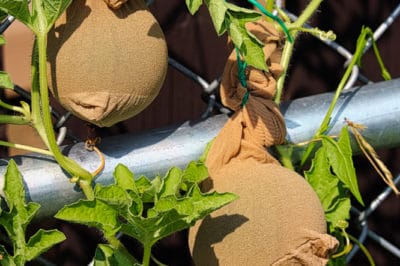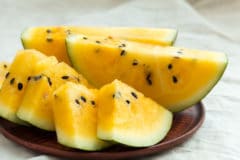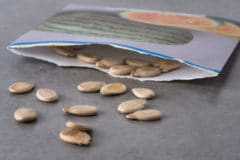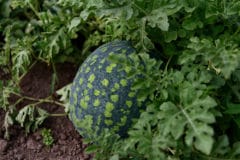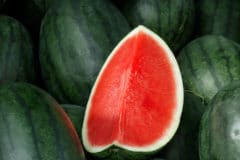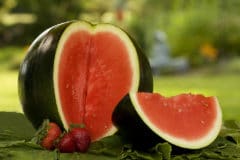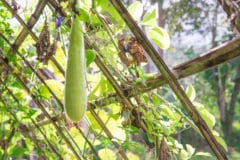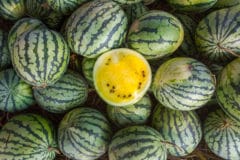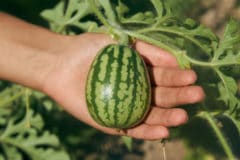Selecting the Best Variety
The first step in growing vertical melons is selecting an appropriate variety that works well growing on a trellis-like structure. Some varieties of melon fruits, especially watermelons, can grow quite large and heavy, making them not a good choice for suspension.
When selecting a variety to grow choose a dwarf cultivar that generally has shorter vines and smaller fruits that won’t topple the structure holding them or break their holders.
Watermelon
- ‘Golden Midget’ produces 3-pound fruits, with golden yellow skin and pink inner flesh. Matures in around 70 days.
- ‘Sugar Baby’ produces 9-pound fruits, with green skin and red flesh. Matures in about 75 days.
- ‘Snack Pack’ produces 3- to 4-pound fruits, with dark green skin and red flesh. Matures in around 75 days.
Cantaloupe (Muskmelon)
- ‘Serenade’ produces 1.5- to 2-pounds fruit with greenish-white skin and thick orange flesh. Matures in about 78 days.
- ‘Tasty Bites’ produces 1.75- to 2.5-pound fruit with an pale orange skin and thick orange flesh. Matures in around 80 days.
- ‘Sugar Cube’ produces 2- to 4-pound fruit with heavily netted skin and thick orange flesh. Matures in about 80 days.
Container & Site Selection
Whether you are growing your melons vertically planted in containers or directly in the ground, it’s important to meet the plant’s needs to get them off to a good start. When the melon plant’s cultural needs are met, you can expect vigorous vines producing flowers and fruits.
Container requirements include:
- Large container, such as a 5-gallon per plant, with bottom drainage.
- Use a rich potting mix that drains well.
Garden soil requirements:
- Loose, fertile soil that’s been amended with well-rotted manure or compost.
Select a location where the melon plants get sun for the majority of the day. Too much shade negatively affects flowering and fruiting.
Selecting & Using a Vertical Structure
The most important thing when selecting and using a vertical structure is that it is sturdy. There’s a lot of choices in suitable materials for the melon vines to climb upon and gardeners can create a permanent structure like an arbor, or even use a temporary structure using strings and wire.
Strong and sturdy is important because even dwarf cultivars of melons have some weight to them. If you have three or four developing fruits putting stress on the structure, the last thing you want is for it to collapse. Then you end up with damaged melons on the ground. Therefore, installing a trellis directly in the melon container isn’t advised.
Already Installed Fencing
If you have a privacy fence or even a chain-link fence that’s located in a sunny space, you can easily let your melon plants climb upon them. This alleviates the needs to create a structure.
In-Ground Growing
If growing the melon plants directly in the ground by the fence, simply remove any weeds or grasses from an area around 3 feet by 3 feet per plant, and prepare the soil with organic matter. Once completed, plant your melon seeds and water well.
Using Containers
For those growing in containers and utilizing the fence, simply place the container next to the fence and plant as usual. To prevent pest and disease problems, situated the container on a weed- and grass-free area.
Wooden Lattice
Wooden lattice panels are relatively inexpensive and easy to use in making a quick and sturdy vertical trellis system. You can attach the corners to a garden wall, or create a freestanding system by attaching sturdy poles to the sides. Be sure the outer poles are long enough that you can bury them several feet into the ground. You want to make sure it’s sturdy and the lattice doesn’t fall over with weight.
Arbor or Trellis
If you already have an arbor or sturdy trellis in place, you can simply move the container or plant directly by it for the vines to scramble up. If you are installing one for the melon vines, once again, it’s important you have the bottom portion buried deep enough in the ground or installed in buckets of concrete so it stays upright.
Helping Vines & Fruit
Whatever type of vertical structure you decide to grow your melon vines up, you are going to need to give them assistance, since they aren’t expert climbers. Once the vines get long enough and without undue stress, carefully direct the vines onto the bottom portion of the trellis system.
Since melon’s are grow quickly, expect to check your plants daily and help direct the newly developing side shoots to open areas of the trellis.
Supporting the Fruit
Once your melons reach the size of a golf ball or tennis ball, it’s time to support them. For smaller melons, any type of pantyhose works well, but if you are growing melons with a bit of size to them, you’re going to need a stronger material. Anything like heavy-duty pantyhose, tee shirt, onion sacks, or any mesh-type material works well.
Create a sling to hold the developing fruit and tie the ends directly to the trellis, lifting the fruit a bit higher than it was originally hanging on the vine, if using pantyhose. As the fruit develops and becomes heavier, it will cause the pantyhose to sag. Once the melons reach the ripe stage, simply cut the sling from the trellis and remove the melon to enjoy.
